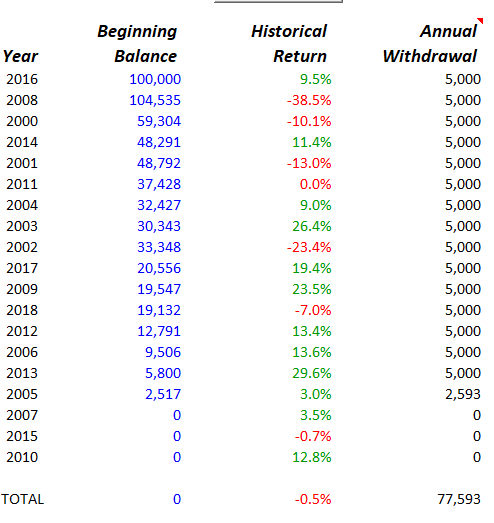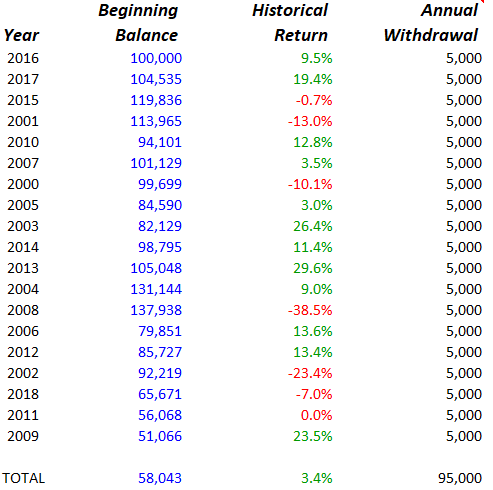One Retirement Risk You May Have Overlooked
No one wants to think their retirement security could depend on some stock market luck. But in a way, unless you've accounted for what's known as sequence of returns risk, bad luck could dash your dreams.


There’s a serious retirement risk out there that you might not have heard of, and it could have the power to determine the kind of retirement you will have. Have you thought about how sequence of returns affects your retirement?
The sequence of returns, or the order of the returns in your portfolio, does not matter until you start taking withdrawals out of an account. During your accumulation years while you’re working, you are not subject to this risk because you are not withdrawing money. But when you retire (during your distribution phase) you will be.
First, you must have a mind shift when going into retirement. You must go from an accumulation-only mindset to a distribution, preservation and an accumulation mindset. Just simply rolling your 401(k) into a portfolio and putting more of your assets in fixed income tools, like bonds, is not how you will eliminate sequence of returns risk.

Sign up for Kiplinger’s Free E-Newsletters
Profit and prosper with the best of expert advice on investing, taxes, retirement, personal finance and more - straight to your e-mail.
Profit and prosper with the best of expert advice - straight to your e-mail.
Sequence of returns risk is a result of the timing of withdrawals from a retirement account that can have a negative impact on the overall rate of return on the investment. This may seriously hurt a retiree who depends on the income stream from a lifetime of investing.
What is sequence of returns?
Sequence of returns is pretty much a matter of luck, meaning if you retire during a bull market and start taking withdrawals, your assets will most likely last longer than if you retired and started taking income from an account during a bear market. Considering that the current bull market is the longest in history, this concept could be more important than ever right about now.
Ever wonder why different people have different opinions of investing in the market during retirement? Look at the hypothetical examples showing having $100,000 in the market during a 10-year period and withdrawing 5% each year. You will see that the order of the returns of the market plays a big role in the final outcome. Keep in mind, both of these women experienced the same, real-world rates of return for their portfolios, just in a different order.
An Example: Two women with the same returns, but one goes broke
Initial Balance: $100,000
Withdrawal Rate: 5.00%
Betty Example No. 1

JoAnne Example No. 2

Note: This hypothetical example is for informational purposes only and is not indicative of past, nor intended to predict future performance of any Index or annuity product.
Is it fair to say that the sequence of returns JoAnne experienced may have provided a better result with the market than Betty ? If you look back, you will see they both started with $100,000 however, Betty ran out of money after 15 years, withdrawing a total of $77,593, while JoAnne has withdrawn $95,000 over the same amount of time and still has $58,043 left in her account.
What can you do to protect yourself from sequence of returns risk?
- Use the right tools for the right job. For income, do not put money into a vehicle like the stock market where the sequence of returns plays a big part. Instead, put it into an investment that will guarantee you a payout for life, like an annuity. By guaranteeing your living and lifestyle expenses are covered, you can put your other assets into investments that you won’t be pulling money from on a consistent basis, such as ETFs and bonds.
- Separate your assets into buckets that work for you differently. For example, secure liquid funds needed for large purchases in the beginning years of retirement in a stable vehicle in one bucket of assets, such as a bank account, money market account or CDs. In the next bucket, supplement your Social Security with other products that provide lifetime income, such as annuities. In a third bucket, determine your probable long term care costs and put money in a hybrid long term care product that does not have ongoing costs. That way you will have your long-term care needs covered down the road. All of your remaining assets should be put into an investment vehicle like ETFs, equities, bonds and mutual funds for future growth to keep up with inflation and taxes.
- Meet with a financial professional looking out for your best interest who is a fiduciary.
Did you know one of the biggest concerns for retirees is running out of money — even over death? Why risk your income in retirement based on the order of the returns of the market?
Protecting yourself against sequence of return risk means being prepared for the worst-case scenario. Don’t assume that you will have a bull market during all your retirement years.
Amy Buttell contributed to this article.
Licensed Insurance professional. Investing involves risk, including the loss of principal. No Investment strategy can guarantee a profit or protect against loss in a period of declining values. Any references to protection benefits or lifetime income generally refer to fixed insurance products, never securities or investment products. Insurance and annuity products are backed by the financial strength and claims-paying ability of the issuing insurance company.
Get Kiplinger Today newsletter — free
Profit and prosper with the best of Kiplinger's advice on investing, taxes, retirement, personal finance and much more. Delivered daily. Enter your email in the box and click Sign Me Up.

Matthew Schuller is the president and founder of BrightPath Wealth Management. He takes his responsibility as a fiduciary seriously, because he knows how much good wealth management can mean for clients. He has eight years of experience working for a large financial products wholesaler, where he has helped advisers and insurance agents tailor products to their clients' portfolios.
-
 10 Major AI Companies You Should Know
10 Major AI Companies You Should KnowThese 10 AI companies are at the forefront of machine learning. Find out how they’re driving innovation and jostling to be the biggest players in the game.
By Tom Taulli Published
-
 How Baby Boomers and Gen Xers Are Redefining Retirement Living
How Baby Boomers and Gen Xers Are Redefining Retirement LivingBoth generations need to embrace change and leverage real estate as a dynamic asset in their retirement planning. Here's how financial advisers can help, too.
By David Conti, CPRC Published
-
 How Baby Boomers and Gen Xers Are Redefining Retirement Living
How Baby Boomers and Gen Xers Are Redefining Retirement LivingBoth generations need to embrace change and leverage real estate as a dynamic asset in their retirement planning. Here's how financial advisers can help, too.
By David Conti, CPRC Published
-
 How Good Advisers Manage Risk in Challenging Markets
How Good Advisers Manage Risk in Challenging MarketsThey understand the difference between what might be real challenges to an investor's strategy and fear brought on by market volatility.
By Ryan L. Kirk, CFA® Published
-
 Financial Planning's Paradox: Balancing Riches and True Wealth
Financial Planning's Paradox: Balancing Riches and True WealthWhile enough money is important for financial security, it does not guarantee fulfillment. How can retirees and financial advisers keep their eye on the ball?
By Richard P. Himmer, PhD Published
-
 A Confident Retirement Starts With These Four Strategies
A Confident Retirement Starts With These Four StrategiesWork your way around income gaps, tax gaffes and Social Security insecurity with some thoughtful planning and analysis.
By Nick Bare, CFP® Published
-
 Should You Still Wait Until 70 to Claim Social Security?
Should You Still Wait Until 70 to Claim Social Security?Delaying Social Security until age 70 will increase your benefits. But with shortages ahead, and talk of cuts, is there a case for claiming sooner?
By Evan T. Beach, CFP®, AWMA® Published
-
 Retirement Planning for Couples: How to Plan to Be So Happy Together
Retirement Planning for Couples: How to Plan to Be So Happy TogetherPlanning for retirement as a couple is a team sport that takes open communication, thoughtful planning and a solid financial strategy.
By Andrew Rosen, CFP®, CEP Published
-
 Market Turmoil: What History Tells Us About Current Volatility
Market Turmoil: What History Tells Us About Current VolatilityThis up-and-down uncertainty is nerve-racking, but a look back at previous downturns shows that the markets are resilient. Here's how to ride out the turmoil.
By Michael Aloi, CFP® Published
-
 Could You Retire at 59½? Five Considerations
Could You Retire at 59½? Five ConsiderationsWhile some people think they should wait until they're 65 or older to retire, retiring at 59½ could be one of the best decisions for your quality of life.
By Joe F. Schmitz Jr., CFP®, ChFC® Published